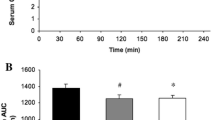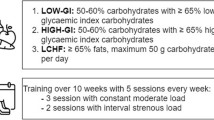Summary
The effect of a pattern of exercise and dietary modification, which is normally used to alter muscle glycogen content, upon the acid-base status of the blood and the ability to perform high intensity exercise was studied. Eleven healthy male subjects cycled to exhaustion on an electrically braked cycle ergometer at a workload equivalent to 100% of their maximal oxygen uptake (\(\dot V_{{\text{O}}_{{\text{ 2 max}}} } \)) on three separate occasions. The first exercise test took place after a normal diet (46.2±6.7% carbohydrate (CHO)), and was followed by prolonged exercise to exhaustion to deplete muscle glycogen stores. The second test was performed after three days of a low carbohydrate diet (10.1±6.8% CHO) and subsequently after three days of a high CHO diet (65.5±9.8% CHO) the final test took place. Acid-base status and selected metabolites were measured on arterialised venous blood at rest prior to exercise and during the post-exercise period. Exercise time to exhaustion was longer after the normal (p<0.05) and high (p<0.05) CHO dietary phases compared with the low CHO phase. Resting pre-exercise pH was higher after the high CHO diet (p<0.05) compared with the low CHO diet. Pre-exercise bicarbonate, PCO2 and base excess measurements were higher after the high CHO treatment compared with both the normal (p<0.01,p<0.05,p<0.01 respectively) and low CHO phases (p<0.001,p<0.01,p<0.001 respectively). Daily dietary acid intake, estimated from food composition tables, was higher than normal during the low CHO diet and lower than normal during the high CHO diet. The present investigation suggests that a predetermined regimen of dietary and exercise variation can significantly affect blood acid-base status and may thereby influence high intensity exercise performance.
Similar content being viewed by others
References
Asmussen E, Klausen K, Egelund Nielsen L, Techow OSA, Tonder PJ (1974) Lactate production and anaerobic work capacity after prolonged exercise. Acta Physiol Scand 90:731–742
Bergstrom J, Hermansen L, Hultman E, Saltin B (1967) Diet, muscle glycogen and physical performance. Acta Physiol Scand 71:140–150
Boobis LH, Maughan RJ (1983) A simple one step fluorimetric method for determination of glycerol in 20 μl of plasma. Clin Chim Acta 132:173–179
Camien MN, Simmons DH, Gonick HC (1969) A critical reappraisal of ‘acid-base’ balance. Am J Clin Nutr 22:786–793
Forster HV, Dempsey JA, Thomson J, Vidruk E, doPico GA (1972) Estimation of arterial PO2, PCO2, pH and lactate from arterialised venous blood. J Appl Physiol 32:134–137
Fuchs R, Reddy Y, Griggs FN (1970) The interaction of cations with the calcium binding side of troponin. Biochim Biophys Acta 221:407–409
Guthrie HA (1983) Introductory nutrition. (5th edition) CV Mosby Company, London, p 123
Hermansen L (1981) Muscle fatigue during maximal exercise of short duration. Med Sport 13:45–52
Hewitt JE, Callaway EC (1936) Alkali reserve of the blood in relation to swimming performance. Res Q Am Phys Ed Assoc 7:83–93
Kirche HJ, Hombach V, Langohr HD, Wacker U, Busse J (1975) Lactic acid permeation rate in working gastrocnemii of dogs during metabolic alkalosis and acidosis. Pflügers Arch 356:209–222
Hultman E, Sahlin K (1980) Acid-base balance during exercise. In: Hutton RS, Miller D (eds) Exercise and sports science reviews. Franklin Institute Press Philadelphia 8:41–128
Hultman E, Bergstrom J, McLennan Anderson N (1967) Breakdown and resynthesis of phosphorylcreatine and adenosine triphosphate in connection with muscular work in man. Scand J Clin Lab Invest 19:56–66
Hultman E, Del-Canale S, Sjöholm H (1985) Effect of induced metabolic acidosis on intracellular pH, buffer capacity and contraction force in human skeletal muscle. Clin Sci 65:505–510
Jacobs I (1981) Lactate, muscle glycogen and exercise performance in man. Acta Physiol Scand [Suppl 495] 1–35
Jones NL, Sutton JR, Taylor R, Toews CJ (1977) Effect of pH on cardiorespiratory and metabolic responses to exercise. J Appl Physiol 43:959–964
McCance RA, Widdowson ED (1960) The composition of foods. MRC Special Report Series No. 297, London H.M.S.O.
Mainwood GW, Worsley-Brown P (1975) The effects of extracellular pH and buffer concentration on the efflux of lactate from frog sartorius muscle. J Physiol 250:1–22
Maughan RJ (1982) A simple, rapid method for determination of glucose, lactate, pyruvate, alanine, 3-hydroxybutyrate and acetoacetate in a single 20 μl blood sample. Clin Chim Acta 122:231–240
Maughan RJ, Poole DC (1981) The effects of a glycogen-loading regimen on the capacity to perform anaerobic exercise. Eur J Appl Physiol 46:211–219
Noma A, Okabe H, Kita M (1973) A new colorimetric microdetermination of free fatty acids in serum. Clin Chim Acta 43:317–320
Osnes JB, Hermansen L (1972) Acid-base balance after maximal exercise of short duration. J Appl Physiol 32:59–63
Saltin B, Karlsson J (1971) Muscle glycogen utilisation during work of different intensities. In: Pernow B, Saltin B (eds) Muscle metabolism during exercise. Plenum Press, New York, pp 289–300
Sahlin K, Harris RC, Nylind B, Hultman E (1976) Lactate content and pH in muscle samples obtained after dynamic exercise. Pflügers Arch 367:143–149
Siggaard-Andersen O (1963) Blood acid-base alignment nomogram. Scand J Clin Lab Invest 15:211–217
Shohl AT (1923) Mineral metabolism in relation to acid-base equilibrium. Physiol Rev 3:502–543
Sutton JR, Jones NL, Toews CJ (1981) Effects of pH on muscle glycolysis during exercise. Clin Sci 61:331–338
Author information
Authors and Affiliations
Rights and permissions
About this article
Cite this article
Greenhaff, P.L., Gleeson, M. & Maughan, R.J. The effects of dietary manipulation on blood acid-base status and the performance of high intensity exercise. Europ. J. Appl. Physiol. 56, 331–337 (1987). https://doi.org/10.1007/BF00690901
Accepted:
Issue Date:
DOI: https://doi.org/10.1007/BF00690901




